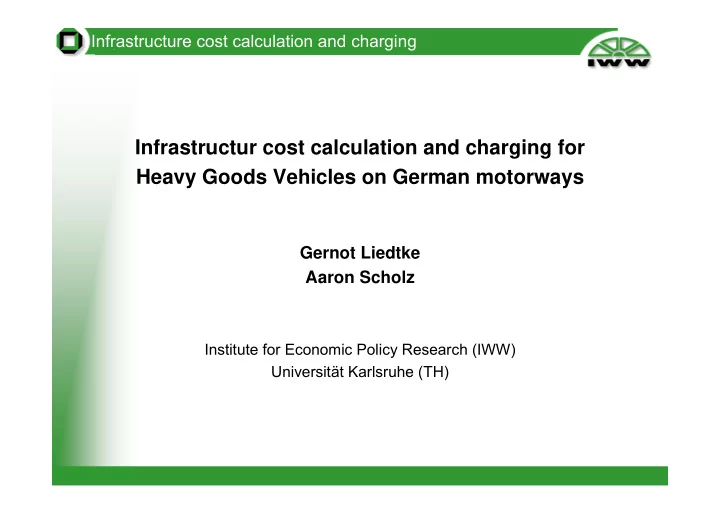

Infrastructure cost calculation and charging Infrastructur cost calculation and charging for Heavy Goods Vehicles on German motorways Gernot Liedtke Aaron Scholz Institute for Economic Policy Research (IWW) Universität Karlsruhe (TH)
Legal framework for HGVs charging Directive 1999/62/EC • sets the general principles on the charging of HGVs for the use of certain infrastructure Directive 2006/38/EC • successor Directive • greater flexibility in toll differentiation • sets core-principles for the calculation and allocation of infrastructure costs ABMG (Autobahnmautgesetz für schwere Nutzfahrzeuge) • conversion of EC-Directives into German law (core-principles for HGV charging in Germany) Lkw-MautV (Lkw-Maut-Verordnung) • regulates operational implementation (e.g. starting date, charging system, etc.) Lkw-MautHV (Mauthöhenverordnung) • sets concrete charges per kilometer MautStrAusdehnV (Mautstreckenausdehnungsverordnung) • regulates the incorporation of some highways in the charging sytem
European example I: Austria (Herry et al., 2001) Unit replacement values by expert estimations, Applied to the whole inventory of roads and structures, Calculation of annuities, Stochastic survival functions, Cost allocation by using allocation keys derived from regression analysis. Cons: Pros: • Sum of depreciations ≠ initial investment expenses • Implementation simple • Not compatible with national investment plans • Complex allocation schema • Fallacious regression, focus on capacity-demand allocation-keys • No link to engineering knowledge • Simple survival model
European example II: DIW method (PIM) - cost calculation Expenditures from (federal) budget, Investments aggregated into 4 homogeneous groups, Stochastic survival functions, Linear depreciation of replacement values. Cons: Pros: • Danger to “forget” cost elements • Implementation easy, robust • Disaggregation by links, road types and • Strategic decision support regions impossible (truck is cheap → investments • Sum of depreciations ≠ initial investment expenses into roads) • Possible gap between “real” and “accounted” inventory Problematic when applied to design a tariff system: • PPT models • Other European frameworks
European example II: DIW method (PIM) – cost allocation AASHO, Capacity demand. Problems with the cost allocation approach: Not future-oriented, Incentives for underinvestment and long-term inefficiency, Not fair, Latent danger that all types of overhead costs are allocated by using AASHO factors.
Basic principles of the IWW/ProgTrans approach Fairness • Inter-generational fairness • Intra-generational fairness Theoretical business model • Public or semi-private company Efficiency • Long-term efficiency Life-cycle consideration Economic depreciation
General schema of the IWW/ProgTrans approach Scheme for infrastructure cost calculation and charging for HGV Inventory o f the infrastructure elements by network section and construct ive element Determining the replacement value Gross value of fixed assets by network section and constructive element for t he base year for the base year 2005 Determining the current depreciated value Net value of fixed assets by road section and constructive element for t he base year for the base year 2005 Predict ing the net asset value Predicting the reinvestments Depreciation and interest for the projected years for the projected years for the base year by construct ive element by constructive element and the project ed years. Determining and predicting Determining the total cost the operation al costs for the for the base year and the projected years base year and the projected years Allocation calculation
Asset categories of the disaggragted approach The calculation approach distinguishes between the following asset categories (disaggregated approach): Land acquisition, Earthworks, Road layers (base layer, binder and road surface), Nodes (motorway, junctions and turnoffs), Equipment, Bridges, Tunnels, Motorway service areas (with or without service) and Maintenance depots.
Results of the disaggregated approach German trunk road network (displayed: hilliness indicator) Bridges of the German trunk road network (Source: BASt)
Results of the cost calculation Total cost of the federal motorways 2007 (in billions of Euro)
Cost allocation principles of the IWW/ProgTrans approach Total infrastructure cost = sum of the cost of all links and nodes, Cost of each link = sum of the cost of all structures belonging to the link, Cost of each structure consists of, • Short term variable cost, • Traffic load dependent fixed cost, • Basis cost. Minimization of total cost = minimization of cost for all structures according to life cycle cost considerations, Allocation of total cost inspired by Shapley formula • Incremental cost, • Uniform and capacity-dependent allocation keys, • AASHO .
Conclusions - Outlook Facilities of the approach: • compatible with CBA, • principles of engineering decision making fulfilled, • International Accounting Standards, • Difficult to manipulate (disaggragted approach). Future oriented approach, Gives right incentives for efficient investments, Methodology is suited for: • changes in business model, • regulation of private operators, • detailed sub-network analysis. Applicable for: • railway networks and airports, • energy transmission grids, • telecommunication networks.
Infrastructure cost calculation and charging Feedbacks are welcome !! gernot.liedtke@iww.uni-karlsruhe.de aaron.scholz@iww.uni-karlsruhe.de
Recommend
More recommend